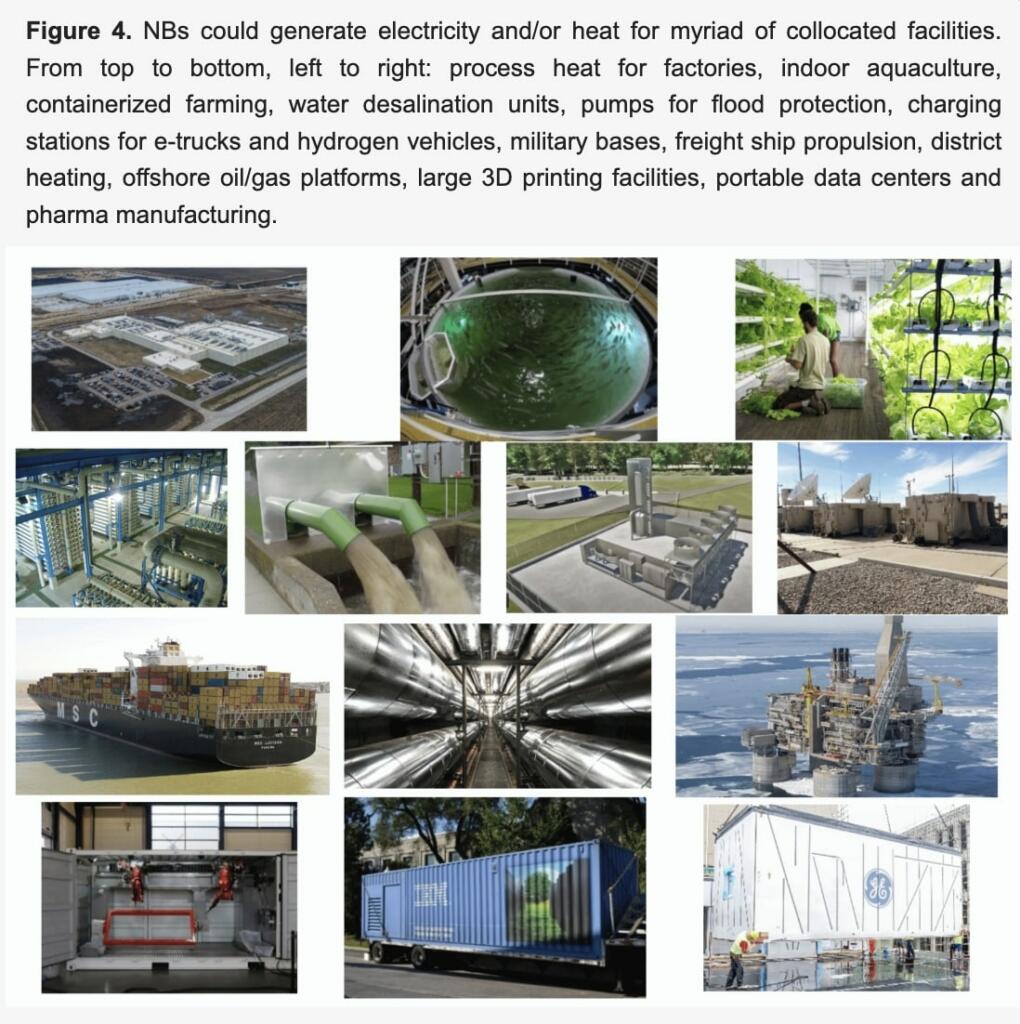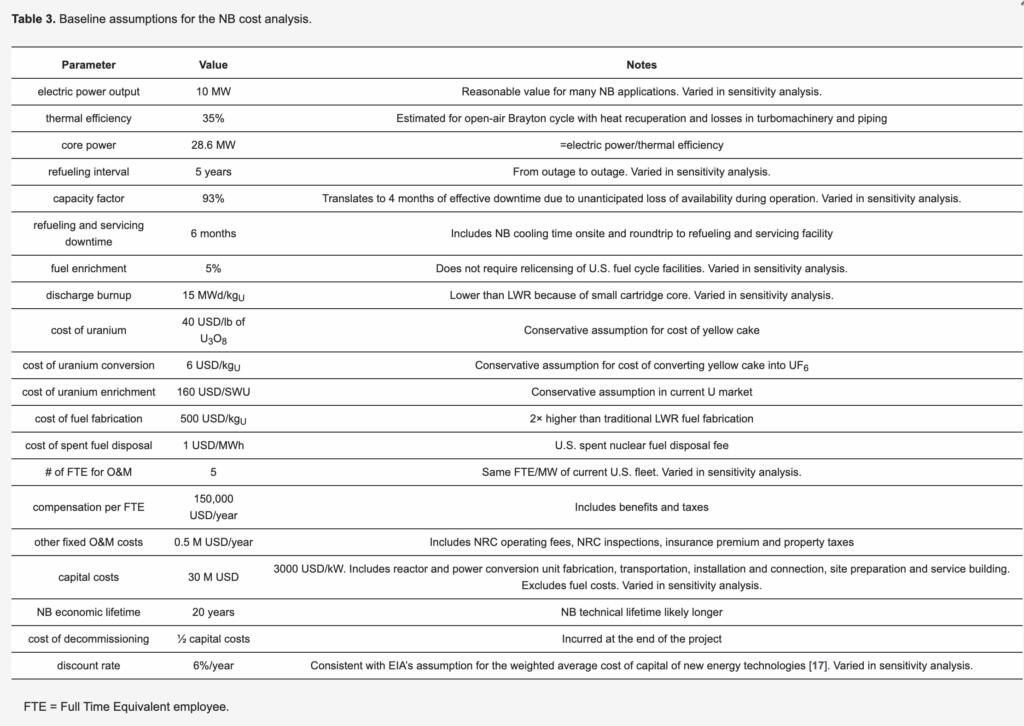Shell Oil and Southern Electric utility company had a 2021 research paper that explored if nuclear batteries could be economical for generating power.
(Above – (a) MIT’s conceptualization of a nuclear battery (NB) with integrated gas turbine; (b) LANL’s Megapower; (c) NASA and LANL’s KRUSTY/Kilopower reactor using Stirling engine technology for space applications; (d) Westinghouse’s eVinci heat pipe micro-reactor; (e) Radiant Nuclear’s high-temperature gas-cooled micro-reactor.)
China made a mass producible coin sized nickel-63 nuclear battery that produces 0.1 milliwatts for 50 years. There are other isotope materials which could produce far more power. Russia, NASA and other space agencies have used plutonium and uranium for nuclear thermal generators to make up to a few hundred watts of power for multi-year and even multi-decade space missions.
Shell Global and Southern electric looked at the use case of nuclear battery as a standardized, factory-fabricated, road transportable, plug-and-play micro-reactor. Nuclear batteries have the potential to provide on-demand, carbon-free, economic, resilient, and safe energy for distributed heat and electricity applications in every sector of the economy. The cost targets for nuclear batteries in these markets are 20–50 USD/MWht (6–15 USD/MMBTU) and 70–115 USD/MWhe for heat and electricity, respectively.
A single 10 MW Nuclear Batteryy can power some 7000–8000 homes or a large shopping mall or a mid-size data center, or produce enough desalinated fresh water for over 150,000 people. It could also power electric car and truck charging stations.
Ten 10-MW NBs, providing a stable energy supply of 100 MW, would occupy roughly 4000 square meters (including the security area), with an installed power density of 25,000 W/m2. By comparison, a 100-MW wind farm of 3-MW turbines placed in a square grid has an installed power density of about 2–3 W/m2 and thus occupies at least 33,000,000 m2, often in dual use with agriculture.

A wind farm of 100 MW requires about 20,000 tons of steel, 50,000 tons of concrete as well as 900 tons of plastics used in the blades. Solar PV farms of similar installed power would require 50% larger total amount of material, albeit less steel than wind. Ten Nuclear batteries generating 100 MW would require about 20 tons of low enriched uranium, as well as about 1600 and 4600 tons of steel and concrete, respectively, which include the transportation cask and dry casks for the spent fuel.
The capacity factor for a nuclear system is high, typically around 0.9, the capacity factor of wind and solar PV farms is generally low, typically 0.35 and 0.2, respectively, and varying seasonally which requires significant storage capacity to be installed alongside. The 10 Nuclear batteries are actually equivalent to a wind plant of nominal capacity 260 MW or a solar plant of nominal capacity 450 MW, and the aforementioned material requirements for wind and solar need to be scaled up accordingly for a meaningful comparison.
The wind plant needs about 25-30 times as much steel and concrete and plastic as the nuclear battery. The Solar farm needs 40-50 times as much steel and concrete.
The study shows the cost levels and efficiencies that are needed where nuclear batteries become broadly competitive.’
There are military and space applications where the compact and lower weight nuclear battery can first be developed and used.
This study did not examine if other radioactive isotopes can be developed for applications in the milliwatt to hundreds of watt power ranges.








Brian Wang is a Futurist Thought Leader and a popular Science blogger with 1 million readers per month. His blog Nextbigfuture.com is ranked #1 Science News Blog. It covers many disruptive technology and trends including Space, Robotics, Artificial Intelligence, Medicine, Anti-aging Biotechnology, and Nanotechnology.
Known for identifying cutting edge technologies, he is currently a Co-Founder of a startup and fundraiser for high potential early-stage companies. He is the Head of Research for Allocations for deep technology investments and an Angel Investor at Space Angels.
A frequent speaker at corporations, he has been a TEDx speaker, a Singularity University speaker and guest at numerous interviews for radio and podcasts. He is open to public speaking and advising engagements.


For outer planet probes, they would be great.
Any SMR concepts ( and these really are SMR’s on the low end of the power spectrum) would benefit from supercritical CO2 power cycles with air cooled radiators, if they run hot enough. There’s also knock-on effects for other thermal power sources as well, provided they are hot enough.
Designing for higher heat output, both for easier power cycle heat rejection and process heat applications, is an important market consideration. Process heat for industrial use and HVAC is a critical step in overall energy use, but the highly distributed nature and small scale of individual users is such a barrier compared to incumbent systems (typically natural gas fired steam boilers).
One could probably make a physically large beta-battery using a clever rolled/paged capacitor-like design (many layers) and a beta-emitter like Sr90… This would preclude using it like an RTG, which would require an insulated red-hot slug. Many PWRs have Self Powered Neutron Detectors (SPND) which generate nano-amp currents from 13mg segments of rhodium up the center of instrumented fuel assemblies, while at power. Betas that escape the detector and betas that slow down in the detector both contribute to the signal. Such a thing (large capacitor with beta-emitting dielectric) might scale indefinitely all the way up to kilowatts and meters cubed, save for the incoming dirty-bomb and fuel reprocessing implications.
The fission concepts… none of them are batteries.